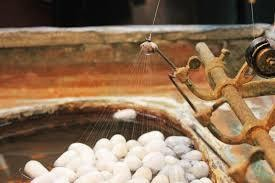
What is silk reeling?
A. The process of taking out threads from the cocoon is called reeling.
B. When the eggs hatch into larvae, they are fed on mulberry leaves.
C. The cocoons are dipped in hot water and the silk fibres are separated.
D. The cocoons are dipped in an Iodine solution and the silk fibres are separated.
Answer
567.3k+ views
Hint: The process by which silk is produced is known as sericulture. Extraction of the raw form of silk involves the cultivation of the silkworm on mulberry leaves as the first step.
Complete answer:Silk reeling is a step in the process of Sericulture which involves the reeling of cocoon waves to produce a single thread. Thus, the process is done by taking out threads from the cocoon. There are different types of reeling methods, which are a direct method that involves processing on a reel of standard size and the indirect method by using a number of small reels and then re-reeled using a standard-sized reel. The former method is used in the traditional silk production process. Before the process of reeling begins, the cocoons are processed in hot water and are boiled, to initiate the process of unveiling the silk thread.
Thus, the process of reeling of silk can be explained as the action of taking out threads from the cocoon that is option A.

Note: The whole process of production of silk fibres is a multi-step process. Silk is considered as one of the strongest fibers of natural origin. The fibre provides a cool feel on touch since it has a high emissivity of Infrared Light. Silk is resistant to almost all types of mineral acids. Chemical dissolution of silkworms produces Regenerated Silk Fibers (RSF) where silk fibres are dissolved to form thinner microfibrils which get reassembled to form a single thread, thus the material being stiffer than the original silk.
Complete answer:Silk reeling is a step in the process of Sericulture which involves the reeling of cocoon waves to produce a single thread. Thus, the process is done by taking out threads from the cocoon. There are different types of reeling methods, which are a direct method that involves processing on a reel of standard size and the indirect method by using a number of small reels and then re-reeled using a standard-sized reel. The former method is used in the traditional silk production process. Before the process of reeling begins, the cocoons are processed in hot water and are boiled, to initiate the process of unveiling the silk thread.
Thus, the process of reeling of silk can be explained as the action of taking out threads from the cocoon that is option A.

Note: The whole process of production of silk fibres is a multi-step process. Silk is considered as one of the strongest fibers of natural origin. The fibre provides a cool feel on touch since it has a high emissivity of Infrared Light. Silk is resistant to almost all types of mineral acids. Chemical dissolution of silkworms produces Regenerated Silk Fibers (RSF) where silk fibres are dissolved to form thinner microfibrils which get reassembled to form a single thread, thus the material being stiffer than the original silk.
Recently Updated Pages
A man running at a speed 5 ms is viewed in the side class 12 physics CBSE

State and explain Hardy Weinbergs Principle class 12 biology CBSE

Which of the following statements is wrong a Amnion class 12 biology CBSE

Two Planoconcave lenses 1 and 2 of glass of refractive class 12 physics CBSE

The compound 2 methyl 2 butene on reaction with NaIO4 class 12 chemistry CBSE

Bacterial cell wall is made up of A Cellulose B Hemicellulose class 12 biology CBSE

Trending doubts
What are the major means of transport Explain each class 12 social science CBSE

Which are the Top 10 Largest Countries of the World?

Draw a labelled sketch of the human eye class 12 physics CBSE

Explain sex determination in humans with line diag class 12 biology CBSE

The pH of the pancreatic juice is A 64 B 86 C 120 D class 12 biology CBSE

Give 10 examples of unisexual and bisexual flowers




